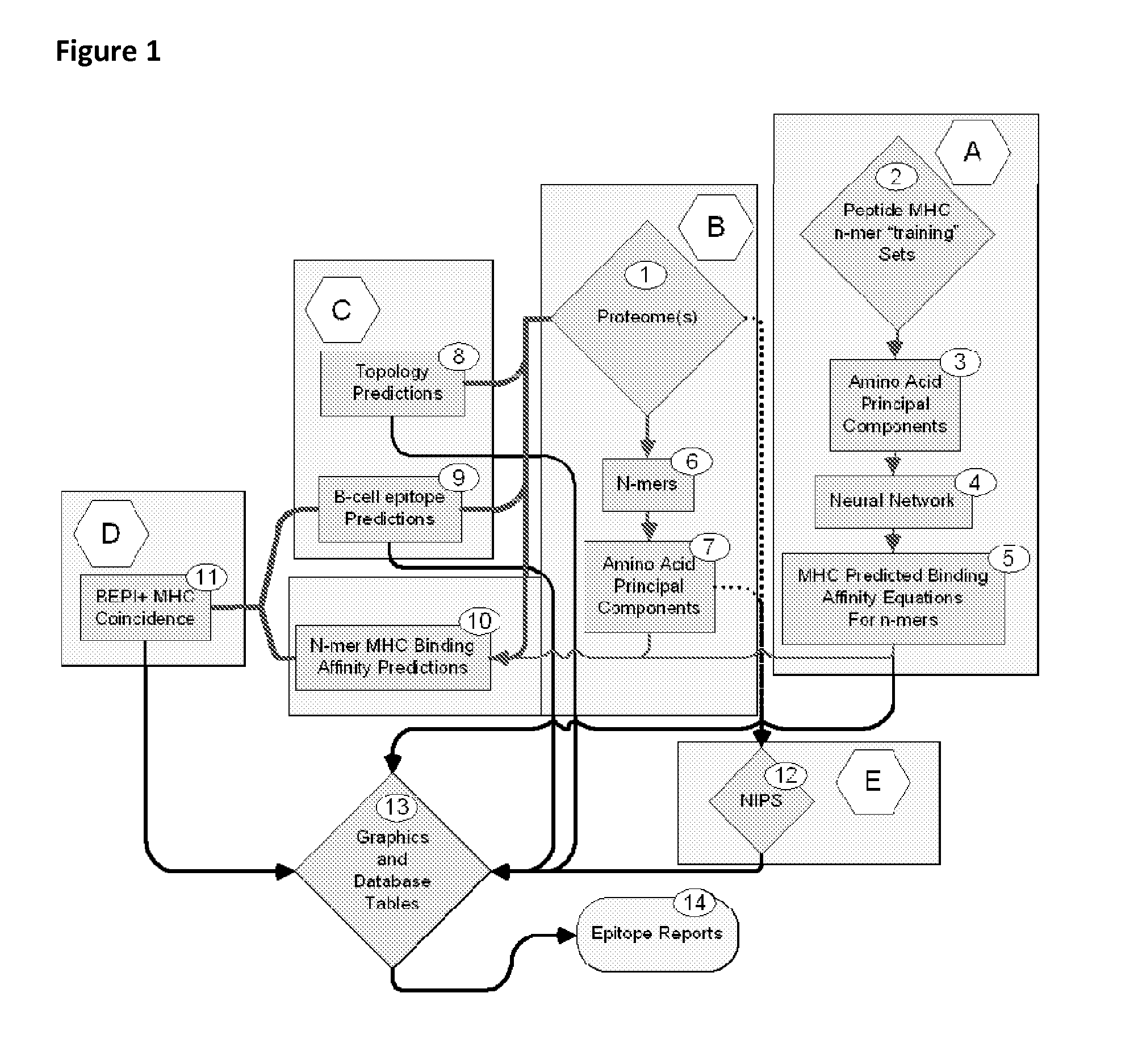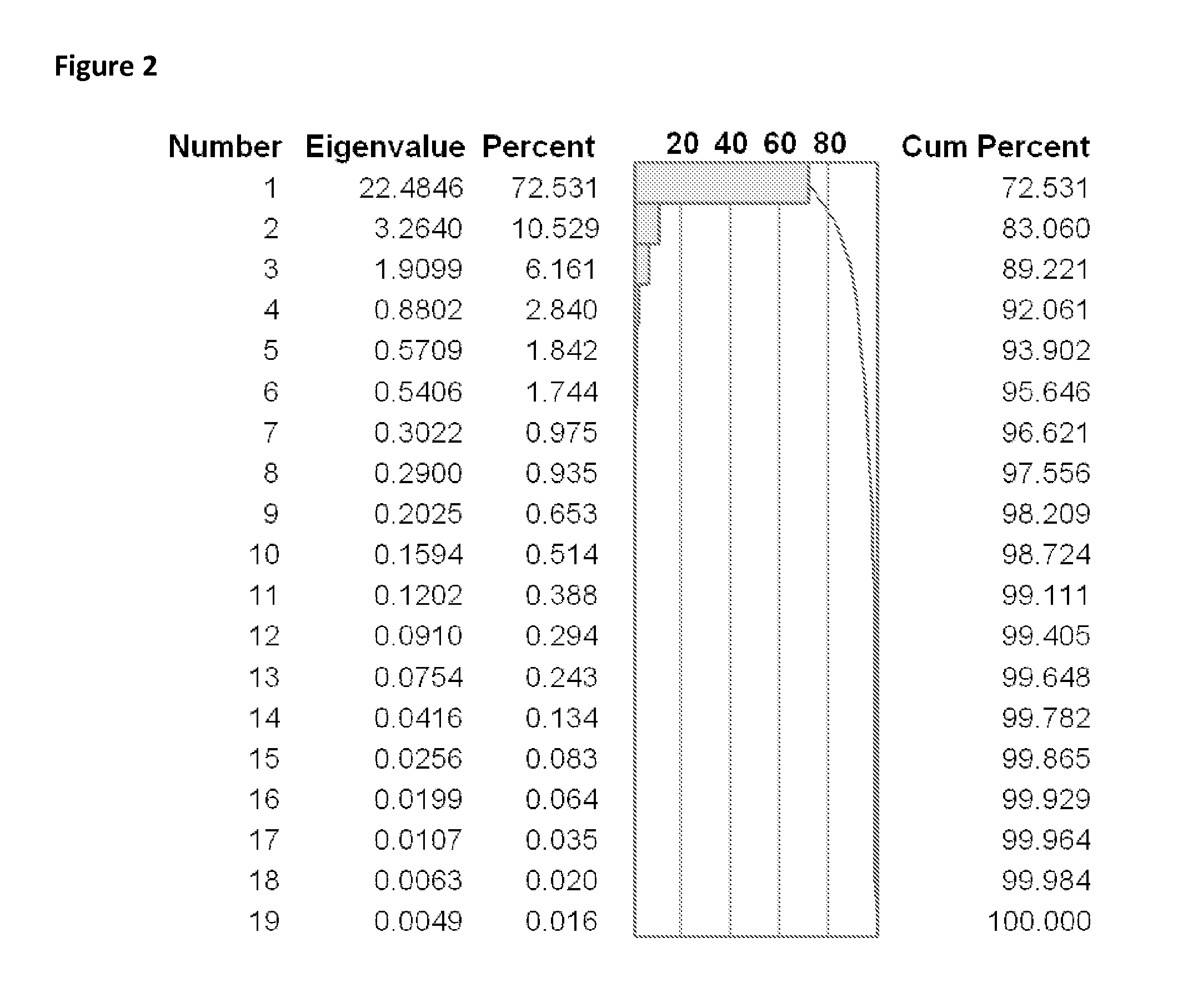Bioinformatic processes for determination of peptide binding
a bioinformatics and peptide technology, applied in the field of identification of peptide binding to ligands, can solve the problems of antibiotic resistance, disproportionate contribution of antibiotic resistant bacteria, and an important cause of mortality worldwide, and achieve the effect of high probability and high probability of being effective in stimulating humoral and cell-mediated immune responses
- Summary
- Abstract
- Description
- Claims
- Application Information
AI Technical Summary
Benefits of technology
Problems solved by technology
Method used
Image
Examples
example 1
Correlation with Experimental Data for Certain Staphylococcus aureus Surface Proteins
A. Thermonuclease (Nase) SA00228-1 NC—002951.57650135
[0303]Thermonuclease, also called Nase or micrococcal nuclease, is highly immunogenic and has been the subject of numerous studies. We examined the output of three such publications, cited in detail below. This is an example of different potential confusion in epitope mapping because of different numbering systems. Genetic maps of Nase molecule (Shortle D (1983) Gene 22 (2-3): 181-189) indicate three potential initiation sites, the longest of which would produce a protein of 228 amino acids. The work of Schaeffer et al (Schaeffer EB et al (1989) Proc Natl Acad Sci USA 86 (12): 4649-4653) indicate the protein (obtained commercially for their experiments) is comprised of 149 amino acids. Careful examination suggests of the gene mapping indicates that amino acid 80 (alanine) in the genomic curation (not residue 61 as found in the genomic curations) e...
example 2
Correlation with Experimental Data Training Set Made Available by the Jenner Institute
[0327]The Jenner Institute has established a reference data set of B epitopes based on meta-analysis of published information. This is considered an authoritative resource for testing B epitope predictors. As downloaded from a repository site at (cbs.dtu.dk / services / BepiPred / ) the dataset consisted of 124 proteins derived from a very diverse eukaryotic and prokaryotic sources as shown in Table 8.
TABLE 8Data Set provided by the Jenner Institute as a training set of proteins. Sequencesand source information are available atmhcbindingpredictions.immuneepitope.org / dataset.html.AntiJeniD>2505 CAC1A_HUMAN 000555 Voltage-dependent P / Q-type calcium channel alpha-1A subunit (Voltage-gatedcalcium channel alpha subunit Cav2.1) (Calcium channel, L type, alpha-1 polypeptide isoform 4) (Brain calciumchannel I) (BI). - Homosapiens (Human).>192 RAC3_MOUSE P60764 Ras-related C3 botulinum toxin substrate 3 (p21-Rac3...
example 3
Analysis of Differential Binding Affinity of Certain HLA Alleles to Proteins of HTLV-1 Virus
[0332]There is evidence that the clinical outcome of infection with HTLV-1 is linked to the HLA haplotype of the individual infected. This is documented in a number of papers by Kitze and coworkers (Kitze B, Usuku K, Yamano Y, Yashiki S, Nakamura M, Fujiyoshi T, Izumo S, Osame M, Sonoda S (1998) Human CD4+ T lymphocytes recognize a highly conserved epitope of human T lymphotropic virus type 1 (HTLV-1) env gp21 restricted by HLA DRB 1*0101. Clin Exp Immunol 111 (2): 278-285; Yamano Y, Kitze B, Yashiki S, Usuku K, Fujiyoshi T, Kaminagayoshi T, Unoki K, Izumo S, Osame M, Sonoda S (1997) Preferential recognition of synthetic peptides from HTLV-I gp21 envelope protein by HLA-DRB1 alleles associated with HAM / TSP (HTLV-I-associated myelopathy / tropical spastic paraparesis). J Neuroimmunol 76 (1-2): 50-60; Kitze B, Usuku K (2002) HTLV-1-mediated immunopathological CNS disease. Curr Top Microbiol Immun...
PUM
| Property | Measurement | Unit |
|---|---|---|
| pH | aaaaa | aaaaa |
| pH | aaaaa | aaaaa |
| pH | aaaaa | aaaaa |
Abstract
Description
Claims
Application Information
 Login to View More
Login to View More - R&D
- Intellectual Property
- Life Sciences
- Materials
- Tech Scout
- Unparalleled Data Quality
- Higher Quality Content
- 60% Fewer Hallucinations
Browse by: Latest US Patents, China's latest patents, Technical Efficacy Thesaurus, Application Domain, Technology Topic, Popular Technical Reports.
© 2025 PatSnap. All rights reserved.Legal|Privacy policy|Modern Slavery Act Transparency Statement|Sitemap|About US| Contact US: help@patsnap.com



